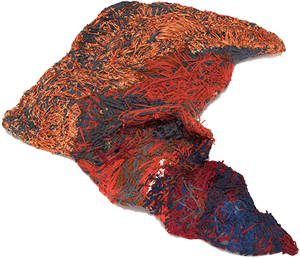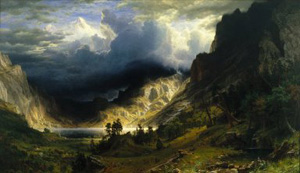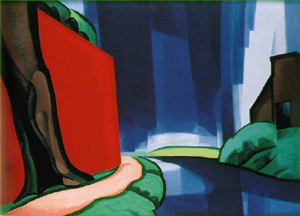A Greater America
John Haberin New York City
American Folk Art Museum: Multitudes
Brooklyn Museum and Whitney Museum: Rehanging the Collection
Is outsider art on the margins or breaking bounds? After sixty years, the American Folk Art Museum is still asking what it means to be art. It is unsettling what defines folk art for the future. But then a museum on its anniversary and a museum of this art has every right also to look back.
Sure enough, on returning (finally) from lockdown, it uses the occasion to show off its collection. It cannot exactly claim to rehang the collection, for it has never had space to hang it alongside temporary exhibitions in the first place. Now it packs in four hundred objects.  You may still think of outsider art as awkward, obsessive, and stiff, no matter how many times the museum and collectors object. Once again, though, awkward translates into crazed and obsessive into sheer exuberance. As the display's title has it, folk art contains "Multitudes."
You may still think of outsider art as awkward, obsessive, and stiff, no matter how many times the museum and collectors object. Once again, though, awkward translates into crazed and obsessive into sheer exuberance. As the display's title has it, folk art contains "Multitudes."
When the Brooklyn Museum and Whitney Museum rehang their collections, expect a focus on American art. That has always been Brooklyn's strength, culminating in a stormy view of the Rockies by Albert Bierstadt, and the Whitney's very mission. You can expect, too, renewed attention to diversity. That has become pretty much mandatory, and the Brooklyn Museum has long styled itself as a neighborhood institution reaching out to a diverse borough. Is there still room for surprises? Now and then, but they may not add up to a fresh view of art.
Leaps and bounds
Museums after Covid-19 are looking desperately for an audience, but also first and foremost to themselves. The Met, the Modern, the Frick, the Whitney, and the Brooklyn Museum have all rehung their collections—sometimes on account of construction projects and almost always planned long ago. And the Folk Art Museum has always drawn on its holdings, as an unmatched source of outsider art. They have brought life to subjects from Art Brut and American Modernism to "Photo Brut" and "Made in New York City." Here they must work harder still. Even before one has left the lobby, one will have seen such stalwarts as Adolf Wölfli and Henry Darger, with more of Darger's sly Vivian Girls yet to come.
One will also have seen a look back at past exhibitions on video, as (sure enough) "Pushing Boundaries." Did you know that Ammi Phillips once hung alongside Mark Rothko? It sure sounds implausible to cast Phillips as the painter of color and light, although a child wears a startling red dress. You may remember only a girl with a dog at her feet, cuddling a cat. Still, why apologize for the painter's grasp of tradition? American portraits will never outgrow their reputation for stiffness, even famous portraits, but her insight into faces is anything but tried and true.
This is not a survey of American folk art. It runs neither chronologically nor by theme, and it omits such figures as Morris Hirshfield. Some work stands alone, as collections in themselves. Annie Hooper has dozens of her sculpted women, crying out for salvation from the very Jesus half buried in their midst. They could be worn down, frightened, self-assertive, or literally casting spells, but there is no escaping their driftwood, shells, and cement. Another platform has no end of tinted photos, many anonymous, as another wild ride in themselves.
More, though, depend on juxtapositions across whatever boundaries you can name. That sounds like a recipe for disaster—yet another case of curators too clever for their own good. In practice, though, it is an invitation to look. Maybe folk art has some surprises left after all. Maybe it always had affinities with the mainstream. Besides, the museum is doing its best with tight space.
To find it all, look alive. Working-class Americans from the Webb family stand on a high shelf, easily overlooked. Think of their carved wood as solid but simple, like the workers themselves? Duck into a narrow corridor, where Morton Bartlett has his photos of marionettes—truly stiff, but carefully posed, strongly lit, and strangely alive. From there, it is just a step to Justin McCarthy's dangerous faces in oil on masonite and then actual early American portraits. It gives them all a new lineage, one that might well encompass the modern and postmodern puppet shows of Sophie Taeuber-Arp and Laurie Simmons as well.
Sandstone by William Edmondson might belong to a dead civilization, but it leads to another sculpted woman, by Judith Scott, bound in the thread of her making. She in turn leads to thread paintings all about confinement and indifference, by Mary K. Borowski. Some take pride in boundaries after all, like Sam Doyle with his portraits of the Gullah community in South Carolina. The museum also includes samplers and quilts, with motifs from sunbursts to pointing hands out of African culture. Still, if you see premonitions of Pop Art in World War II collage by Daniel J. Rohrig and the Long Ranger for Mary Paulina Corbett, you would not be far wrong. They have their boundaries, too, even as they break them.
Delaware in Brooklyn
Right off the elevator at the Brooklyn Museum, you will find yourself in Lenapehoking, or the Lenape nation, more familiar till recently as the Delaware. That, too, has quickly become a given—from Native American art and the Native American name on the Broadway billboard in Socrates Sculpture Park to a period room for Afrofuturism at the Met. Brooklyn provides a tribal map, claiming much of the country's northeast, and a goal for the collection. It also promises a broader definition of American art, to include all the Americas. Why, then, does do the Lenape all but vanish from that point on? The very commitment to a broader view gives out after the first room or two, but that may still be enough for an eye-opener—even with a further rehanging of the American wing due in little over a year.
The Woodland cultures of Florida contribute sleek carvings, as plummets in the shape of turtle heads or birds, and the Shoshone an elk hide with images of horses. It looks downright contemporary, close to the spontaneity of watercolor and with riders suspended in midair. As for broadening, carvings by Bernardo Miera y Pacheco have a cryptic cast that one could mistake for indigenous myth. They were, though, pilasters for a Catholic church. Myths and visions return in the nineteenth century, with paintings of idle children and black "money diggers." Here, too, the obvious moral cannot disguise a clash of cultures.
 So far so good, and the Americas extend as far as the Andes. Images of indigenous people recur, by Harry C. Edwards in 1921, amid familiar portraits by John Singleton Copley and Gilbert Stuart (one of a hundred of George Washington). African American art recurs one last time with Nick Cave. Sill, you can see a pattern. The rehanging is not about creating new contexts or alternative traditions. It is exhilarating but practically incoherent. It is teaching lessons that may not make sense.
So far so good, and the Americas extend as far as the Andes. Images of indigenous people recur, by Harry C. Edwards in 1921, amid familiar portraits by John Singleton Copley and Gilbert Stuart (one of a hundred of George Washington). African American art recurs one last time with Nick Cave. Sill, you can see a pattern. The rehanging is not about creating new contexts or alternative traditions. It is exhilarating but practically incoherent. It is teaching lessons that may not make sense.
The lessons come fast and furious. They tell of how Europeans elevated a "pristine" world in order to dominate it. They do, that is, apart from the museum's classic genre scenes by George Caleb Bingham, William Sidney Mount, and William Michael Harnett. Then, too, Bierstadt's storm seems so dramatic only because people had to live with it. The very founder of the Hudson River School, Thomas Cole, paints the great outdoors as grounds for a picnic. A video of churning waters beside them, by Lorraine O'Grady, brings out the darkness.
Sometimes text does add insight. Harnett includes four types of tobacco, and a newspaper protrudes over the ledge, because they would have appealed to a Broadway banker. Other text is routine, like a reminder that the rising bourgeois bought art. Still more is confused, like a heading for European art as extending from Claude Monet to Berthe Morisot—nicely alliterative, but a small circle and an age gap of less than two months. Christopher Columbus before the Spanish queen, by Emanuel Leutze, falls under "eclectic naturalism." Large carvings from coastal people are stunning, but does it help to reference climate change?
The American wing at the Philadelphia Museum truly can create new contexts, because it has a far larger collection to sustain a greater imagination. Brooklyn still has its highlights—also including a woman's red choker by Thomas Eakins, a painter and his companion by John Singer Sargent, and a strength in prewar urban art. They should amply reward a fresh look. Still, the museum goes back on its welcome, with "pay what you will" no longer covering special exhibitions, however far from a blockbuster. Bierstadt loses something, too, at the end of a corridor. Maybe just forget the text, but keep an eye out for what it means to be the American people.
The rules of rehanging
So many museums have been rehanging their collections that one could reduce it to a formula. Take the institution's strength, in the time and place that brought it into being in the first place. Do not, though, rest content with the postcard images that keep the public coming, not in a world that demands rediscoveries and a greater diversity. Sum it all up in a statement: "in addition to well-known artists like . . ., the museum provides a broader perspective with such groundbreaking, historically overlooked artists as . . . ." You and the museum can fill in the blanks.
Now the Whitney Museum does just that as "At the Dawn of a New Age." It gives over its top floor to early American Modernism, almost exclusively from the permanent collection, and I have already taken wording from the wall text and press release. But wait: that is a floor for temporary exhibitions, and the collection hangs as always a floor below. Those "well-known artists" include Aaron Douglas, and every one of the overlooked is a new name to a self-appointed expert like me. As for the modern city of Edward Hopper and Hopper's New York, the factories of Charles Sheeler, or the determined Modernism of those who sought out Gertrude Stein in Paris or Alfred Stieglitz at his Fifth Avenue gallery, 291, better head downstairs.
The Whitney, then, takes seriously bringing new names to art history and new lives to old ones, whether the collection does or not. It announces no less with its opening wall for Marsden Hartley, Oscar Bluemner, Agnes Pelton, and Georgia O'Keeffe. They will be recurrent notes throughout, and only Bluemner is indisputably a straight white male. The broadening also includes attention to Bay Area artists like Isami Doi, a native of Hawaii—and the list of overlooked has only one white male as well, Ben Benn, a Jew from today's Ukraine. Oh, and just in case you did not know,  Douglas was a major figure in the Harlem Renaissance. His woodcuts after The Emperor Jones, like the play by Eugene O'Neill, put a black man front and center with an ambivalent relation to Africa and America.
Douglas was a major figure in the Harlem Renaissance. His woodcuts after The Emperor Jones, like the play by Eugene O'Neill, put a black man front and center with an ambivalent relation to Africa and America.
Is this the real American century, at long last? Rooms divide roughly by subject between landscape, with forests and bathers, and still life. Cubism and Henri Matisse leave their mark everywhere. Still, Hartley studied with an Impressionist, William Merritt Chase—and his horses and iron crosses on black point suggest Symbolism instead, the language of Hilma af Klint. Like the man by Albert Bloch ascending through mountains toward a shining church, this is visionary company. Few beyond Stuart Davis, Patrick Henry Bruce, and a black artist, Charles Duncan, take the leap to abstraction. Few, too, beyond Louise Nevelson in red chalk reclaim a woman's body from the male gaze.
Sculpture stands out for its sense of life, including the head of a Congolese woman by Nancy Elizabeth Prophet, standing women by Elie Nadelman, and an African dancer by Richmond Barthé. (Isamu Noguchi contributes abstract forms on paper.) Photography appears only twice, with shimmering still life by Taizo Kato and Imogen Cunningham, and design not at all apart from textiles by Loïs Mailou Jones. Nor does architecture, although Helen Torr might be looking straight at the Guggenheim Museum ceiling. Prints have a place, with Douglas and Doi, bringing the boldness of woodcuts and linocuts to art deco. Sill, one must leave modern prints by women to a recent past show focused on American Abstract Artists.
The show's heart, then, lies in painting. Bigger names may come as a greater Modernism and a relief, like churning waters for John Martin, but they also make for strategic pairings. Sunlight bursts from a dark forest for Charles Burchfield, while the moon for Bluemner rises between dark rocks and blue sky. Pelton's seas lead to a budding flower by Henrietta Shore as Trail of Life. Synchrony for Stanton Macdonald-Wright spins every which way, and who knew that E. E. Cummings, the poet, was also a painter? Breaking up her appearances does not serve O'Keeffe well, even next to Florine Stettheimer, but it takes time to bring a formula to life.

"Multitudes" ran at the American Folk Art Museum through September 5, 2022, "At the Dawn of a New Age" at The Whitney Museum of American Art through January 2023. The American wing of the Brooklyn Museum returned February 11.




